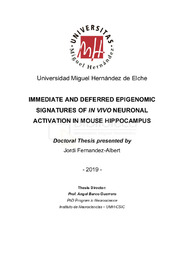Por favor, use este identificador para citar o enlazar este ítem:
https://hdl.handle.net/11000/29714
Immediate and deferred epigenomic signatures of in vivo neuronal activation in mouse hippocampus
Título :
Immediate and deferred epigenomic signatures of in vivo neuronal activation in mouse hippocampus |
Autor :
Fernández-Albert, Jordi |
Tutor:
Barco Guerrero, Ángel |
Editor :
Universidad Miguel Hernández de Elche |
Departamento:
Instituto de Neurociencias |
Fecha de publicación:
2019-10-29 |
URI :
https://hdl.handle.net/11000/29714 |
Resumen :
This thesis describes the genomic regulatory events occurring in the nucleus of hippocampal excitatory neurons of adult behaving mice upon activation. It provides both novel cutting-edge methods in neurogenomics and a repository of novel next generation sequencing datasets with broad utility that open new avenues for the investigation of the genomic mechanisms underlying neuronal plasticity.
The integrative and longitudinal multi-omics analysis of transcriptional and chromatin dynamics after status epilepticus and experience-driven neuronal activation unveils molecular mechanisms that are likely to contribute to metaplasticity in the adult brain. Most of these molecular processes are described here for the first time in the context of neuronal activation in vivo. In particular: the identification of transcripts displaying activity-dependent ribosome-engagement; the detection of several species of activity-induced ncRNAs in the nucleus; the description of the dramatic impact of transcriptional bursting in chromatin accessibility at the gene body and enhancers of activity-induced genes; the de novo binding of activity-regulated transcription factors; the augmented promoter-enhancer interactions at activity-regulated genes; and the formation of gene loops that bring together the TSS and TTS of actively transcribed genes and may sustain the fast re-loading of RNAPII complexes. Notably, the identification of chromatin occupancy and interaction changes that remain long after the transcriptional burst, particularly those driven by AP1, showed a correlation with deleterious consequences of status epilepticus. Which could underlie the changes in neuronal responsiveness and circuit connectivity observed in these neuroplasticity paradigms, perhaps thereby contributing to a genomic memory.
To reach these findings, I introduce methods that we expect will become standard in the field of Neurogenomics. These include the optimization of procedures for fluorescence-activated nuclear sorting (FANS) and their combination with genetic GFP-tagging of the nuclear envelope, which allowed cell-type specific analyses using a wide range of NGS technologies in vivo. In particular, we generated high coverage profiles for ribosomal-bound mRNA-seq (translatome), nuclear RNA-seq (transcriptome), ATAC-seq (chromatin accessibility, TF-footprinting and nucleosome positioning), ChIP-seq (protein-chromatin interactions), and the first Hi-C map (chromatin-chromatin interactions) in hippocampal excitatory neurons, both in the basal state and after activation with a glutamate agonist. Furthermore, the combination of this approach with nuclear immune-staining against Fos allowed the isolation of nuclei from excitatory neuronal-ensembles activated in response to the exploration of a novel context and the investigation of the chromatin changes occurring in these cells in response to experience.
|
Palabras clave/Materias:
Neurociencias |
Área de conocimiento :
CDU: Ciencias aplicadas: Medicina: Patología. Medicina clínica. Oncología: Neurología. Neuropatología. Sistema nervioso |
Tipo de documento :
info:eu-repo/semantics/doctoralThesis |
Derechos de acceso:
info:eu-repo/semantics/openAccess |
Aparece en las colecciones:
Tesis doctorales - Ciencias de la Salud
|
 La licencia se describe como: Atribución-NonComercial-NoDerivada 4.0 Internacional.
La licencia se describe como: Atribución-NonComercial-NoDerivada 4.0 Internacional.
 La licencia se describe como: Atribución-NonComercial-NoDerivada 4.0 Internacional.
La licencia se describe como: Atribución-NonComercial-NoDerivada 4.0 Internacional.
.png)
